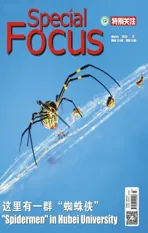“Spidermen” in Hubei University
2019-04-11TextbyMaYalunTangLinPhotosbySuZhuolin
Text by Ma Yalun & Tang Lin Photos by Su Zhuolin

Hubei University, an important provinciallevel university in Wuhan, the capital city of Central China's Hubei Province, is proud to boast a team of talented spider researchers and scientists in its School of Life Sciences.
Prof. Zhao Jingzhao, Prof. Chen Jian, Prof. Jiao Xiaoguo, and their graduate students, forming a long line of four generations, have pooled together and made great achievements in the research of spiders. Recently, a paper named “Prolonged milk provisioning in jumping spiders” was released in Science, a top SCI journal, marking the joint effort of Prof. Jiao Xiaoguo, Associate Prof. Zhang Shichang of Hubei University and Chen Zhanqi and Quan Ruichang of Xishuangbanna Tropical Botanical Garden, Chinese Academy of Sciences. This paper composed their great contribution to the field of biology for their initial discovery in breastfeeding in invertebrates. It is noteworthy that Chen Zhanqi, the first author of the paper, was also a graduate of Hubei University.
A World of Spiders
Entering one of the spider laboratories in Hubei University, we saw rows of shelves, as high as 2 meters each. The shelves are filled with various bottles and jars in which spiders of different varieties live. These spiders come from all over the world, including some remote corners of China. This small laboratory is a giant world of spiders, where all the famous spiders, such as Tarantulas and black widow spiders can be seen.
Prof. Jiao told us that his research team mainly focuses on the research dealing with pardosa pseudoannulatas, pardosa astrigeras, and bird-eating spiders.
We observed closely the birdeating spiders from Hainan Province in China and South America. They are likely to dig out caves in wet mud and hide there. These spiders, covered with brown straight hair, as if combed by the barber, remind us of the spider spirits in the Journey to the West. This kind of spider is nocturnal, and lives on insects. One bird-eating spider, hiding in its cave, stretches its legs, making good preparation to attack in a timely manner. The gray and black bulges on the front end of the legs are its claws. It is magical that the claw does not snag things when the spider isn't attacking, but when it starts to attack, the claws grip tightly on prey. Prof. Jiao further explained spiders' secrets concerning venom, limb coordination, and weaving skills. He put a bird-eating spider on the back of one hand, and touched it with the other while speakingto us, “Spiders are not as toxic or dangerous as most people think.”

After we left the laboratory, Prof. Jiao guided us to the specimen room, where seven researchers were studying spider specimens. A lady turned on the light, moved past the meters-high file cabinets, and explained to us the categories of specimens.
“Here is where more than 100,000 spider specimens are kept.”
The cabinets are full of glass bottles, one after another. Immersed in formalin liquid, spiders, big and small, still are bright in color and their thin hairs are intact. Prof. Jiao explained to us that these spiders were all collected or bred by the team. Chen Jian, the vice dean of the School of Life Sciences, takes the lead in the research of the diversity of species amongst spiders. He and his team travel hundreds of thousands miles every year to search for spiders of different species in mountains and caves around China. So far, they have left their footprints in Xinjiang, Tibet, Yunnan, Guizhou, and many other remote regions. Tombs, caves, high mountains, and virgin woodlands are the ideal places for them to seek new spiders.
Bright Future for the Application and Marketing of Spiders
In the 1970s, when Hubei University was called Wuhan Teachers College, Zhao Jingzhao, a teacher then, was designated to study the prevention and control of farmland crop creatures. He found that spiders are a natural remedy for pests in cotton fields, which ushered in the beginning of the application of spiders for biological control.
After 50 successive years of development, Hubei University leads in the research of spiders in China. The School of Life Sciences has nurtured hundreds of doctoral and master's graduates since then. Right now 40 students are pursuing their doctoral and master's degrees at the center. Hubei University is now on the path of internationalization in its research. For example, they invited Prof. Ingi Agnarsson from the University of Vermont from the US and Prof. Matjaz Kuntner from Slovenia to work here as visiting professors.
At present, many other universities in China also have spider research centers, which embrace many scholars, and have attained great achievements and expanded the field of research on spiders. With government sponsorship and funding, spider research now has a good academic climate, and more and more talents have blossomed at a faster speed.
Nowadays, the research of spiders mainly focus on the study of Arachnids and their application in pest control and prevention, as well as applications in Bionics and Material Science. With the application of spiders in biological control, pesticides will be used less, thus soil and water contamination will continue to decrease. Application in Bionics and Material Science also provides potential for development in many fields. The spider web, with characteristics of high intensity, fast elongation rates, and good tenacity, can be applied to the textile, medical, and military industries. What's more, progresses have been achieved in the treatment of rheumatism using the venom from the spiders. The study of spiders' limb coordination will definitely shed light on advanced construction equipment, rescue work, and other fields.
这里有一群“蜘蛛侠”
文/马亚伦 唐琳 摄影/苏卓琳
在中国中部湖北省省会武汉,有一所省重点大学——湖北大学。这所大学的生命科学学院里,活跃着中国力量最强的一群“蜘蛛侠”。
他们星火传承,从赵敬钊到陈建到焦晓国再到年轻的研究生团队,四代同功,在蜘蛛研究领域取得不少成就。不久前国际权威学术期刊《科学》杂志上刊登的论文《一种跳蛛的长期哺乳行为》,就是该院焦晓国教授、张士昶副教授与中科院西双版纳热带植物园科研人员陈占起、权锐昌等合力完成的。他们首次发现无脊椎动物类似于哺乳动物的哺乳行为,这是对世界生物学领域的贡献。值得一提的是,论文第一作者陈占起也是该院硕士毕业生。

蜘蛛的世界
走进该院实验室,一排排高2米左右的架子映入眼帘,架上挤满了各式各样的瓶瓶罐罐,瓶内饲养着大大小小物种不同的蜘蛛。它们或来自世界各地,或来自中国偏远地方的某一个角落。一个小小的室验室竟是一只只蜘蛛的乾坤。狼蛛、黑寡妇……大凡知名,这里全有。
据焦晓国教授介绍,他们主要研究拟环纹豹蛛、星豹蛛和捕鸟蛛。我们近距离观察了来自海南、美洲等地的捕鸟蛛。它们在潮湿的土里刨了洞穴,将自己整个儿藏在里面,全身清晰可见密生的棕褐色细毛,像理发师梳理过的头发,干净、晶莹发亮,令人想起《西游记》里的蜘蛛精。这种蜘蛛多在夜间活动,以各种昆虫为食。藏在洞穴里的捕鸟蛛,全力张开头腹部的脚,随时作出进攻的架势,脚趾前一二节上灰黑肉突的部分是它的吸盘,腿部前端灰黑肉突的部分是它的爪子。神奇的是,不进攻时爪部没吸力,一旦进攻,吸力就很大,可以把毛笔头上的毛牢牢吸住。焦教授说,蜘蛛的奥秘还很多,诸如毒液、步足协调、编织技巧等都非常值得深入研究。
焦教授把一只捕鸟蛛放在自己的手背上,边用另一只手抚摸蜘蛛边说:“其实蜘蛛并不像人们想象的那么毒,那么可怕。”
从实验室出来,焦教授带我们参观了蜘蛛标本室。七八位研究员正在进行标本研究。一位女士把灯打开,并把一排排几米高的蜘蛛档案柜移动开,给我们讲解标本分类情况。
这里存放着10万多个蜘蛛样本。一个个玻璃器皿挤满了档案柜,一个种类挨着一个种类。大大小小的蜘蛛浸泡在福尔马林液中,仍能看到鲜艳的颜色和细长的绒毛。焦教授介绍,这些蜘蛛标本都是团队亲自捕捉或培养的。该院副院长陈建是蜘蛛物种多样性研究的领头人,他和他的团队每年都要跑数万公里,常年在全国各地的山野洞穴中寻找不同种类的蜘蛛,足迹遍布新疆、西藏、云南和贵州等偏远省区,古墓荒洞、深山老林,是他们最喜欢的去处。


蜘蛛应用前景广阔
20世纪70年代,湖北大学还叫武汉师范学院,该校赵敬钊教授(当时只是讲师)受命开展农田生物防治研究。他发现蜘蛛是棉田害虫的天敌,由此拉开利用蜘蛛开展生物防治的研究序幕。

陈建教授(后排左三)、赵敬钊教授(后排左五)和他们的同事Professor Chen Jian, Professor Zhao Jingzhao and their colleagues
经过近50年的发展,湖北大学蜘蛛研究全国闻名,已培养博士和硕士研究生数百名,实验室现有40多名博士和硕士研究生。为促进其国际化发展,该校还邀请了美国佛蒙特大学的安内尔森教授和斯洛文尼亚的康特纳教授担任客座教授。
如今,中国多所大学都有蜘蛛研究团队,蜘蛛研究呈现学者辈出、成果丰硕、研究领域不断拓展的局面。国家也鼓励开展生物学领域研究,科研条件得到很大改善,人才培养速度也大大加快。

目前,蜘蛛研究重点在蛛形研究和应用研究。后者又分病虫害防治及材料学、仿生学应用,其中,病虫害防治旨在减少农药施用、降低污染、保护土壤和水资源。蜘蛛在材料学和仿生学应用方面拥有广阔的发展空间。蜘蛛丝具有高强度、高伸长率、高韧性等特点,在纺织、医疗、军事等领域都有广阔应用前景;蛛毒在治疗风湿病方面已经取得进展;蜘蛛多足协调的研究,必将为施工、救援等工具领域创新提供新的操控系统理论。
